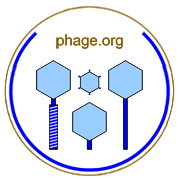

Random molecular motion associated with heat energy that results in movement of untethered materials found within fluid environments.
As diffusion is random motion, it can result in movement both up and down concentration gradients. Net diffusion, however, generally results in movement of substances from regions of high concentration to regions of low concentration. Phage-associated concepts related to diffusion include that of plaque halos as well as phage adsorption constants.
The primary means of by which phages move about from location to location is via diffusion. Other mechanisms of movement, however, can also be important including fluid flow, bulk movement, and movement in association with motile organisms such as animals. In addition, for phages which are not yet free there also is movement as associated with the movement of their host cell.
The diffusion of phage virions generally is slower than that of individual molecules, even whole enzymes, due to the much larger size of virions, which generally are multi-protein and nucleic acid structures. Bacteria, in turn, generally diffuse more slowly than virons due to the typically much larger size of the bacterial cells. In general, rates of diffusion in fact are inversely proportional to size, with larger molecules, objects, or particles diffusing more slowly than smaller things.
For more on this topic, see Wikipedia, Google, and PubMed. Contact web master. Return to terms.